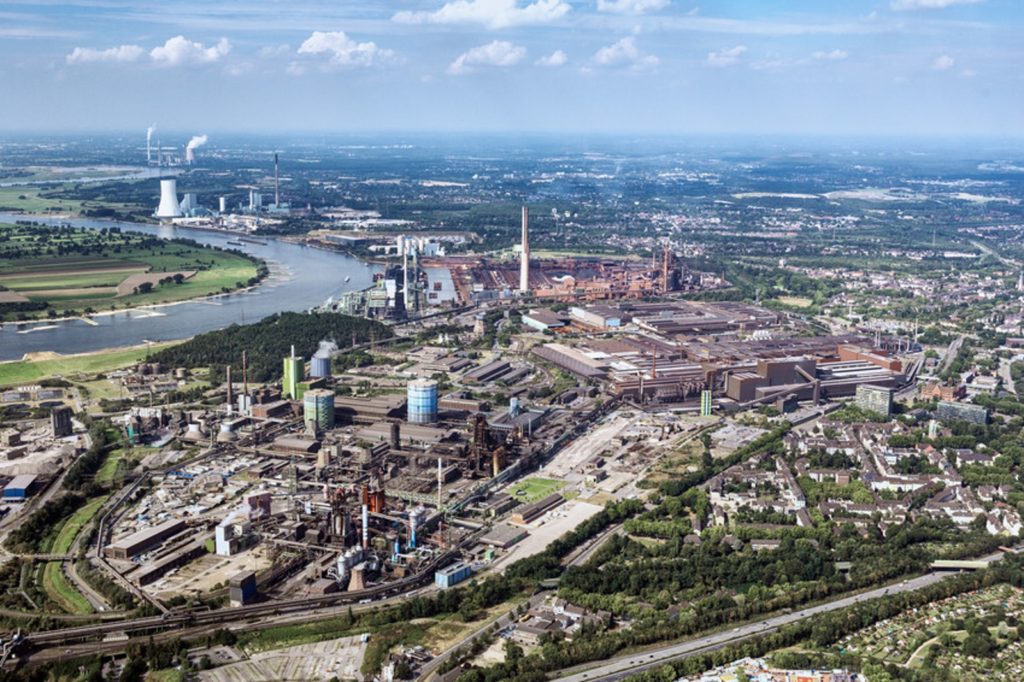Green hydrogen from an RWE Generation electrolyser could help thyssenkrupp Steel Europe sustainably reduce CO2 emissions from steel production in the future. The energy company and the steel producer have agreed to work together towards a longer-term hydrogen partnership. The first hydrogen is set to flow to the Duisburg steel mill by the middle of the decade.
The hydrogen required for iron production is to be produced by electrolysis, in which water is broken down into hydrogen and oxygen. The companies agree that only electricity from renewable sources should be used to operate the electrolysers. At its power plant site in Lingen, RWE is already planning to build electrolysis capacities that could supply green hydrogen for the iron production of Germany’s biggest steelmaker.
A 100 MW electrolyser could produce 1.7 t of gaseous hydrogen per hour, corresponding to around 70% of the quantity required by the Duisburg steelmaker’s blast furnace earmarked for hydrogen use. This would translate theoretically into around 50,000 t of climate-neutral steel. The conversion of the blast furnace is to be carried out by 2022 – the first important stage of a fundamental transformation process at the end of which the company’s entire steel production will be carbon-neutral.
One of the prerequisites for the collaboration is the development of a dedicated hydrogen network to transport the gaseous hydrogen from Lingen to tkSE’s steel mill site in Duisburg. Pipeline transport of the hydrogen is the most economical delivery option. In dialogue with gas network operators and the authorities, RWE and tkSE therefore want to drive solutions for timely network connection. They believe hydrogen pipeline transport will be possible on the basis of regulations corresponding largely to those currently applying to natural gas delivery.
The GETH2 initiative, in which RWE is involved, is already promoting corresponding solutions. The gas network development plan published on May 4, 2020, in its “green gas variant” for the first time includes calculations for initial hydrogen sections parallel to the natural gas network.
Roger Miesen, CEO of RWE Generation, says: “Hydrogen is of central importance for greenhouse gas abatement in Germany. The National Hydrogen Strategy and the €9 billion funding to be made available will give this future technology the necessary kick-start. In order for a hydrogen infrastructure in Germany to really pick up speed, rapid implementation is now needed, because investment decisions for green hydrogen projects need planning certainty.”
Bernhard Osburg, Chairman of thyssenkrupp Steel: “The planned cooperation with RWE is an important step on our path to climate neutrality. The aimed-for supply quantity would be largely sufficient to supply a blast furnace with green hydrogen and allow the production of climate-neutral steel for around 50,000 cars per year. This shows that climate-neutral steel is possible and we are pressing ahead with the conversion of our production. Nowhere else than in the steel industry can hydrogen be used with a comparable climate protection effect. We therefore expressly welcome the adoption of the National Hydrogen Strategy.”
Hydrogen is a central component of the German government’s decarbonisation strategy. The lightest element in the periodic table can not only replace fossil fuels and raw materials – it also allows flexible, supply-oriented storage of renewable energies. Under the “National Hydrogen Strategy” of the Federal Ministry for Economic Affairs and Energy, up to five gigawatts of electrolysis capacity for hydrogen production is to be created and the hydrogen transport and distribution infrastructure further developed by 2030. Through targeted support and relief the ministry wants to make hydrogen economically viable for producers and users.











